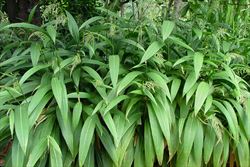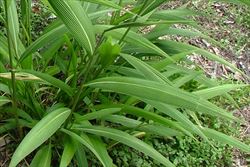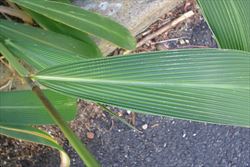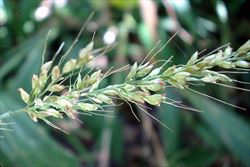Click on images to enlarge

infestation (Photo: Sheldon Navie)

infestation in seed (Photo: Sheldon Navie)

habit (Photo: Sheldon Navie)

habit in flower (Photo: Sheldon Navie)

large palm-like leaf blades (Photo: Sheldon Navie)

close-up of stem and base of pleated leaf blade (Photo: Sheldon Navie)

young seed-head with numerous spreading branches (Photo: Sheldon Navie)

close-up of seed-head in flower (Photo: Sheldon Navie)

close-up of flower spikelets, subtended by long bristles (Photo: Sheldon Navie)

close-up of seeds (Photo: Steve Hurst at USDA PLANTS Database)

young plant (Photo: Sheldon Navie)
Scientific Name
Setaria palmifolia (K.D. Koenig) Stapf
Synonyms
Panicum palmifolium K.D. Koenig
Family
Gramineae (South Australia)Poaceae (Queensland, New South Wales, the ACT, Victoria, Tasmania, Western Australia and the Northern Territory)
Common Names
African palm grass, bristle grass, bristlegrass, broad leaved bristlegrass, broadleaved bristlegrass, Buddha grass, highland pitpit, highlands pitpit, Indian palm grass, knotroot, Malaysian palm grass, palm grass, palm leaf setaria, palmgrass, palm-leaved setaria, pleated pigeon grass, short pitpit
Origin
Native to China, southern Japan, Taiwan, the Indian Sub-continent (i.e. India, Nepal, Pakistan and Sri Lanka) and south-eastern Asia (i.e. Myanmar, Thailand, Indonesia, Malaysia, Papua New Guinea and the Philippines).
Cultivation
This introduced grass has been grown as a garden plant (i.e. ornamental) in the warmer parts of Australia.
Naturalised Distribution
Widely naturalised in Australia, and most common in the coastal districts of eastern Australia (i.e. throughout eastern Queensland and eastern New South Wales). Also naturalised in the coastal districts of south-western Western Australia, in south-eastern South Australia, and on Lord Howe Island and Norfolk Island.
Widely naturalised overseas, including in New Zealand and on several Pacific islands (e.g. Fiji, Western Samoa, the Solomon Islands and Hawaii).
Habitat
This species prefers damp shady habitats and is a weed of urban bushland, closed forests, forest margins, watercourses (i.e. riparian areas), roadsides, gardens, disturbed sites and waste areas.
Habit
A large, tufted, long-lived (i.e. perennial) grass usually growing up to 1.5 m tall, but occasionally reaching up to 2 m in height.
Distinguishing Features
- a large, tufted, long-lived grass usually growing up to 1.5 m tall.
- its upright flowering stems are covered in hairs, particularly near their joints.
- its large elongated leaf blades (40-80 cm long and 3-12 cm wide) are palm-like with a pleated appearance.
- its flower spikelets are arranged in large branched clusters (20-50 cm long) that may be stiff or slightly drooping in nature.
- these flower spikelets (2-4 mm long) are usually subtended by a long bristle (4-10 mm long).
Stems and Leaves
The upright flowering stems (i.e. erect culms) are covered in hairs, particularly near their joints (i.e. nodes). They are generally green in colour and quite robust (3-7 mm thick).
The tufted leaves consist of a roughly hairy (i.e. hispid) leaf sheath and a very large spreading leaf blade. The elongated (i.e. linear-elliptic) leaf blades (40-80 cm long and 3-12 cm wide) are palm-like with a pleated (i.e. plicate) appearance. These leaf blades have rough (i.e. scabrous) but otherwise entire margins and pointed tips (i.e. acuminate apices). Their upper surfaces are mostly hairless (i.e. glabrous), while their undersides are hairy (i.e. pubescent). Where the leaf sheath meets the leaf blade there is a dense row of hairs (i.e. ciliate ligule).
Flowers and Fruit
The flower spikelets are arranged in loose branched clusters (i.e. panicles) usually 20-50 cm long and 2-10 cm wide. These clusters may be stiff or slightly drooping in nature with numerous slender branches, the lower ones up to 20 cm long. The individual spikelets (2-4 mm long) are oval (i.e. ellipsoid) or elongated (i.e. lanceolate) in shape and borne on short stalks (i.e. pedicels) 1-4 mm long. They are usually subtended by a long bristle (4-10 mm long). Each of these hairless green spikelets consists of a pair of floral bracts (i.e. glumes) and two tiny flowers (i.e. florets). The lower floret has only male parts (i.e. three stamens) or is sterile, while the upper floret has both male and female flower parts (i.e. it is bisexual). Flowering occurs mainly during summer.
The mature 'seeds' (i.e. grains or caryopses) are pale brown in colour and remain enclosed within the remains of the flower spikelets. These 'seeds' (about 2 mm long) are egg-shaped (i.e. ovoid), but somewhat flattened.
Reproduction and Dispersal
This species reproduces only by seed, which are mainly dispersed by wind or seed-eating (i.e. granivorous) birds. They may also be spread by water or in dumped garden waste.
Environmental Impact
Palm-leaved setaria (Setaria palmifolia) is regarded as an environmental weed in Queensland and New South Wales.
Legislation
Not declared or considered noxious by any state government authorities.

